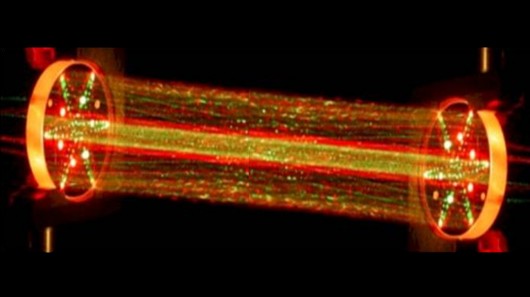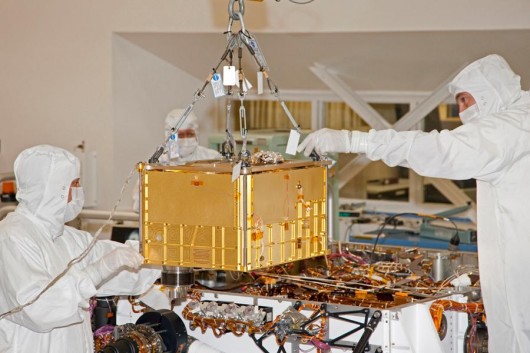Curiosity finding reduces hopes of finding life on Mars
By David Szondy
September 24, 2013

Lab demonstration of the Tunable Laser Spectrometer (Image: NASA/JPL-Caltech)
NASA’s Curiosity Mars rover has detected no methane on Mars after more than a year of extensive testing of the Martian atmosphere using the robot explorer’s Sample Analysis at Mars (SAM) laboratory. Since methane is a key indicator for the presence of biological activity, its absence throws into question the notion that there may be life on Mars today.
The simplest of the hydrocarbons, methane is also the most abundant in the Solar System, making up a large fraction of the atmospheres of the gas giants Jupiter, Saturn, Uranus, and Neptune. On Earth, natural gas is mostly methane and it is produced in surprisingly large quantities by bacteria and other organisms. It occurs at such a basic level of biology that its presence is regarded by scientists as a key indicator that life is present, though it can occur from other sources.
The frustrating and surprising thing about Curiosity’s findings isn't that it found very little methane, but that it found none down to the limits of its ability to detect, which NASA says is well below 1.3 parts per billion. Previous reports had put the presence of methane at around 45 parts per billion, but those were the result of observations by Earth-based telescopes and orbiting spacecraft.
The advantage that Curiosity has is the Tunable Laser Spectrometer, which is part of the SAM laboratory, the largest of the 10 experimental packages carried by the unmanned probe. The spectrometer collects and concentrates the Martian atmosphere inside of itself before shining an infrared laser back and forth through the sample using a series of mirrors. This allows it to measure how much light is absorbed by the gases present and measure their quantity. On six occasions between October of last year and June, Curiosity tested for the presence of Methane and found none.
"It would have been exciting to find methane, but we have high confidence in our measurements, and the progress in expanding knowledge is what's really important," says Chris Webster of NASA's Jet Propulsion Laboratory in Pasadena, California. "We measured repeatedly from Martian spring to late summer, but with no detection of methane."
Installing the Sample Analysis at Mars (SAM) instrument in Curiosity (Image: NASA/JPL-Caltech)
The incredible thing about these findings isn't just the blow it serves to the hunt for life on Mars, it also indicates that the other sources of methane on the Red Planet are almost entirely absent as well. To produce such a negative result, Mars has to produce less than 20 tons of methane per year over the entire planet. That’s about as much as is produced by one 200-head herd of Earth cows.
"There's no known way for methane to disappear quickly from the atmosphere," says Sushil Atreya of the University of Michigan, Ann Arbor. "Methane is persistent. It would last for hundreds of years in the Martian atmosphere. Without a way to take it out of the atmosphere quicker, our measurements indicate there cannot be much methane being put into the atmosphere by any mechanism, whether biology, geology, or by ultraviolet degradation of organics delivered by the fall of meteorites or interplanetary dust particles."
Despite this setback, it doesn't mean that the search for life is over.
"This important result will help direct our efforts to examine the possibility of life on Mars," says Meyer, NASA's lead scientist for Mars exploration. "It reduces the probability of current methane-producing Martian microbes, but this addresses only one type of microbial metabolism. As we know, there are many types of terrestrial microbes that don't generate methane."
The Curiosity results were published in Science Express.
Source: NASA
Copyright © gizmag 2003 - 2013 To subscribe or visit go to: http://www.gizmag.com
